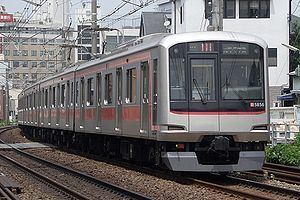Type Commuter rail Opened 14 February 1926 Track gauge 1,067 mm (3 ft 6 in) Locale Kantō region Terminis Shibuya Station, Yokohama | Daily ridership 1,119,453 (FY2010) Line length 24.2 km (15.0 mi) Owner Tokyu Corporation Stations 21 | |
 | ||
Electrification 1,500 V DC overhead catenary | ||
The Tokyu Toyoko Line (東急東横線, Tōkyū Tōyoko-sen) is a major railway line connecting Tokyo (Shibuya) to Yokohama. The line is owned and operated by the private railway operator Tokyu Corporation. The name of the line, Tōyoko (東横), is a combination of the first characters of Tōkyō (東京) and Yokohama (横浜).
Contents
Services
Stations
Key:
Rolling stock
8-car Tokyo Metro 10000 series sets entered revenue service on the Tokyu Toyoko Line and Minatomirai Line from 7 September 2012.
Former rolling stock
History
The first section of the line from Tamagawa to Kanagawa (separate from the present Kanagawa of Keikyu) opened on 14 February 1926. The line was extended incrementally until the entire length from Shibuya to Sakuragichō in Yokohama was opened on 31 March 1932. On 29 August 1964, through service to the Tokyo Metro Hibiya Line via Naka-Meguro Station was started.
On 31 January 2004, the section of Yokohama to Sakuragichō was abandoned. From 1 February, Tokyu Toyoko Line trains started through service from Yokohama to the Minatomirai Line.
On 16 March 2013, the 1.4-kilometer section of Shibuya to Daikanyama was switched to the underground track which connected to the Tokyo Metro Fukutoshin Line at the underground platform formerly used only for Fukutoshin Line and the through service to the Fukutoshin Line was started. The Shibuya terminal on the ground was closed. On the same day, the through service to the Hibiya Line was discontinued.
Incidents and accidents
On 15 February 2014, two trains collided and derailed at Motosumiyoshi station resulting in nineteen injuries. Heavy snow and operations continuing at normal speed were seen as likely causes.
Future developments
Platform edge doors are scheduled to be installed at all stations on the line by 2020.
